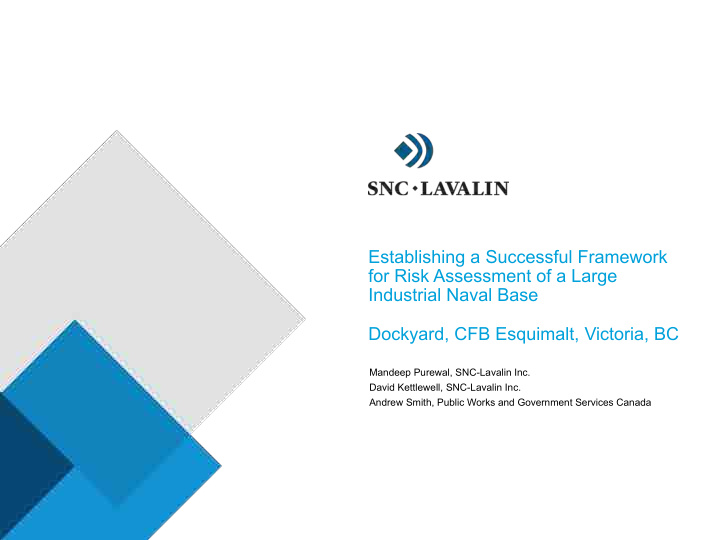



› Establishing a Successful Framework for Risk Assessment of a Large Industrial Naval Base › Dockyard, CFB Esquimalt, Victoria, BC Mandeep Purewal, SNC-Lavalin Inc. David Kettlewell, SNC-Lavalin Inc. Andrew Smith, Public Works and Government Services Canada
CFB Esquimalt Dockyard
Location › Located in Victoria, BC › 32 Ha Industrial Property › Majority of naval engineering, ship repair and maintenance services undertaken at CFB Esquimalt takes place within HMC Dockyard facility. 3
Site History › Traditional grounds of the Songhees and Esquimalt Nations › Royal Navy facilities established in 1855 › A graving dock was completed in 1887 › Circa 1900 › By 1900, industry supportive of Royal Navy and graving dock activities was established on the peninsula › The Esquimalt Village was relocated to the east in the late 1930s 4
Site History (cont’) • Historical activities have included: › blacksmithing › coal storage › waste incineration › machining › petroleum hydrocarbon fuel storage › sandblasting, painting, electroplating › explosives storage › waste oil treatment Primary Contaminants: › hydrocarbons / PAHs › metals 5
Phase I ESA › Previous investigations were limited to specific areas or activities › Resulted in multiple “sites” each with their own investigation information, datasets, reports › Environmental planning focused on individual areas or “sites” › Dockyard information was consolidated in 2011 with a comprehensive Phase I ESA with updated APEC / AEC areas › Updated list of COPCs 6
Information Consolidation › Definition of Project Area › Report Review and Data Consolidation › Data Gap Evaluation › Data Screening for Risk Assessment 7
Historical Risk Managed Areas › Risk Assessments were completed historically for select “sites” › Historical rationale for risk assessment › RMA data gaps / hot spots › Review of reports indicated the need for a larger site wide risk assessment 8
Land Use Unique Setting: › Industrial › Residential › Terrestrial Habitat 9
Risk Assessment: The Challenge › Creating a Workable Risk Management Plan › Significant infrastructure development › Dynamic impacts › Multiple Chemicals › Multiple uses › Exposure Scenarios 10
Risk Assessment: What Makes Dockyard Different? 11
Risk Assessment: The Approach Determining Goals › Address uses and diverse habitat › Needs to be site wide and reflect exposure settings › Must be manageable 12
Risk Assessment: The Results Determine Risk-based Targets › Based on Site Use and Exposure Settings › Allows to Target Specific Areas › Streamline with Site Data Management › Determine Next-Steps 13
CFB Dockyard Framework: Final Thoughts › Take away for other sites: › Use what you have to get a sense of the problem › Historical reports and data › Current and Future Land Use › Find a solution that works for your site › Grouping of APECs/AECs › Re-evaluation of RMAs › Data Gap Assessment and Data Management Approach › Receptor Usage Patterns and Habitats • This approach is applicable for the management of other large sites with multiple historical and current uses, diverse settings and/or on-going operations. Current plans are to use this approach for other large properties of CFB Esquimalt. 14
Thank you. Questions?
Recommend
More recommend